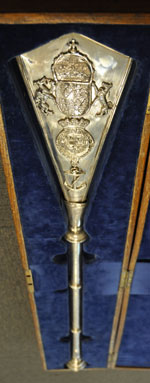History of the Admiralty Court

One of the first mentions in print of the Admiralty Court appears in the Black Book of the Admiralty, a compilation of admiralty law which was created over the course of several monarchs’ reigns. The book states that the High Court of Admiralty was established during the reign of Edward I (1272–1307), although it is now widely accepted that it is more likely that the Court began to emerge after the Battle of Sluys in 1340, and indeed it is Edward III who is now generally credited with its creation in around 1360. At this time it had a Criminal jurisdiction, dealing with matters of discipline in the fleet i.e. crimes and offences involving English ships and crews committed at sea or along the English coastline but outside of a country’s territorial waters, and also a Civil jurisdiction dealing with questions of piracy and spoil (the taking of goods from the enemy during war, hence the phrase “the spoils of war”).
Originally there were 3 separate Admiralty Courts sitting in 3 different parts of the country, each being presided over by a Deputy of the Admiral of the Fleet, but these courts merged early in the 15th century into one high Admiralty Court. The legal procedures were generally based on the common law, but because disputes were often of an international nature, occasionally it began to use Roman civil law rules as used in mainland Europe. It also began to acquire jurisdiction over commercial and other common law cases, taking such work from the Common Law Courts. This brought it into conflict with the judges of these courts, whose position prevailed, and the Admiralty Court began to lose its influence during the 17th century. However, during the 18th century it again rose to prominence, mainly because of the exercise of its prize jurisdiction following various maritime battles.
In 1834 the criminal side of the jurisdiction of the Admiralty Court was transferred to the Central Criminal Court. This was followed 10 years later by an Act of Parliament giving similar powers to the justices of Assize, and from then on the Admiralty Court concentrated only on marine cases involving shipping, collisions and salvage. With the great increase in shipping, particularly steam shipping, the number and gravity of collisions, salvage and damage to cargo, the court’s jurisdiction increased. Judges were assisted by experienced nautical assessors and the court became one of the most important tribunals of the country. In the latter half of the 19th century, reform was demanded by leading industrial, commercial and financial establishments, which were finding that complex commercial cases often required the attention of different branches of law in different courts. This led to the establishment of the Supreme Court of Judicature in 1875, which abolished the old higher courts and established the High Court of Justice and the Court of Appeal. The High Court was divided into 5 specialist Divisional Courts based on the old central courts (King’s (or Queen’s) Bench, Common Pleas, Exchequer (these latter 2 being absorbed into the Queen’s Bench in 1880), and Chancery), together with the addition of the new Probate, Divorce and Admiralty division. In 1882, the Royal Courts of Justice were opened in The Strand.
By the Senior Courts Act 1981, the Probate, Divorce and Admiralty division was abolished and the Admiralty Court (together with the Commercial Court) became part of the Queen’s Bench Division (now King’s Bench Division).
